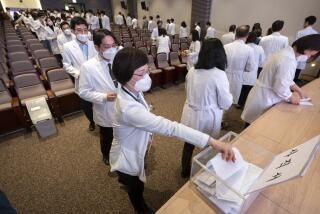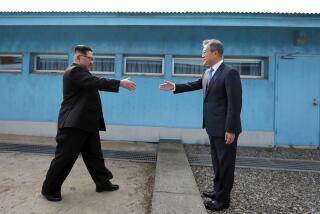Students Aim to Give Bush a Lesson in Diplomacy
SEOUL â As President Bush settled in for the night Tuesday at the U.S. ambassadorâs residence here, Chung Jong Sung and Kim Gyong Joo emerged from under the plastic sheeting that has been their temporary home on the grounds of Myongdong Cathedral to explain their 11-day hunger strike.
It was their way of greeting the American leader.
âPresident Bush is preparing, step by step, to create a mood for war in the Korean peninsula. We are living on only water and salt to protest this action,â said Kim, the president of the student government at Chonnam University.
âThe fate of the Koreas should be left in the hands of Koreans.â
The hunger strike is one of the growing signs of anger, anxiety and frustration with the United States since Bush declared North Korea a member of an âaxis of evilâ in his State of the Union address last month. Whatever the U.S. intent, South Koreans view it as serious meddling that will undermine President Kim Dae Jungâs effort to reunify the divided peninsula.
âBush is set on breaking off the mood of reconciliation created in the Korean peninsula since the June 15 summit [between the leaders of North and South Korea] two years ago. The United States is considering the worst possible action,â said Chung, president of the student government at Kwangwoon University.
As the hunger strikers spoke, Hong Keun Soo, an activist carrying a bullhorn, led several hundred students who were huddled together in the bitter cold on the steps of the cathedral as they chanted: âLetâs stop Bushâs visit to Korea. Bush is a cheap gangster.â
Myongdong Cathedral, in downtown Seoul, was the rallying place in the 1980s for pro-democracy demonstrators who often opposed U.S. support for South Koreaâs then-authoritarian regime, but in recent years, anti-American actions had been minimal.
But Tuesday night, the steps leading up to the cathedral were decorated with banners proclaiming, âNo War, No Bushâ and âAmerican Arrogance Is Inviting Isolation.â
To condemn the tough U.S. language--and to back the hunger strikers--about 1 million students will join the two student presidents in a one-day fast during Bushâs talks with President Kim today, hunger striker Kim said.
The students at the rally also plan to hold shadow protests âto follow Bush wherever he goes,â Chung said.
Of Bushâs three stops on his six-day Asia tour, the South Korean leg is the most sensitive--and susceptible to trouble, despite strong ties between the two countries over the last half a century and the presence of 37,000 U.S. troops in the country.
Students, labor unions and left-wing political activists have staged demonstrations against Bush for several days leading up to the visit. The student demonstrators have been playing cat-and-mouse games with police, using surprise tactics to keep officers off-guard. The uproar has spread into the South Korean parliament, where a senior politician from the ruling party called Bush âevil incarnateâ Monday, setting off a shoving match.
Bush administration officials discount the scope and importance of the demonstrations. âThatâs a celebration of freedom itself--in a place where there is freedom, there is also free speech and the right for people to disagree,â Karen Hughes, the presidentâs counselor, told reporters aboard Air Force One en route to Seoul from Tokyo.
âWe are celebrating their freedom to speak out, even if they disagree--unlike the citizens of North Korea,â she said.
But polls show that a solid majority of the South Korean public disagrees with the Bush administrationâs position on North Korea. A survey published Monday in the Munhwa Ilbo newspaper reported that nearly three-quarters of South Koreans objected to his use of the phrase âaxis of evil.â
A local television poll indicated that the majority believed that the tough U.S. talk carries an ulterior motive: to sell more U.S. arms and warplanes to South Korea. The most popular of several conspiracy theories circulating in Seoul contends that the Bush administration used the threatening language against North Korea to heighten the fear of conflict--and convince Seoul to buy F-15 fighter jets.
To prevent disruptions, the South Korean government has deployed 12,000 riot police to guard the U.S. Embassy and other sites. In addition, the U.S. military is investigating as a possible terrorism attempt an incident Tuesday morning in which two men, one with a Nigerian passport and the other of undetermined nationality, tried to enter a U.S. military base in a stolen car.
As Bush arrived Tuesday night, the embassy was surrounded by hundreds of riot police carrying shields and long sticks. The embassyâs high stone fence was reinforced with a row of buses with steel grates over their windows.
To counter the protests, pro-American demonstrators held welcoming ceremonies in front of the U.S. military base in Seoul to show respect. The crowd of nearly 800 included elderly Korean War veterans, some in their uniforms, waving small American and South Korean flags.
âGeorge Bush is the new MacArthur,â declared Jee Man Won, a conservative military historian, referring to Gen. Douglas MacArthur, who led the U.S. troops who came to South Koreaâs defense in 1950 against Communist North Korea. âBush is the only one with the courage to stand up to North Korea.â
But many political pundits in Seoul are calling the Bush visit an exercise in damage control. The best-case scenario is that nothing new goes wrong to further complicate U.S.-Korean relations, they contend.
Moon Chung In, a political scientist at Yonsei University in Seoul, said Tuesday that some progress could be made if Bush and Kim acknowledged their differences rather than trying to paper them over.
âThese men have different world views, and they need to acknowledge that in order to negotiate. Let different views prevail. President Kim should not try to get George W. Bush to endorse his âsunshine policy,â â Moon said, referring to the South Koreanâs efforts at rapprochement with the North. âThat is a futile diplomatic effort.â
More to Read
Sign up for Essential California
The most important California stories and recommendations in your inbox every morning.
You may occasionally receive promotional content from the Los Angeles Times.










